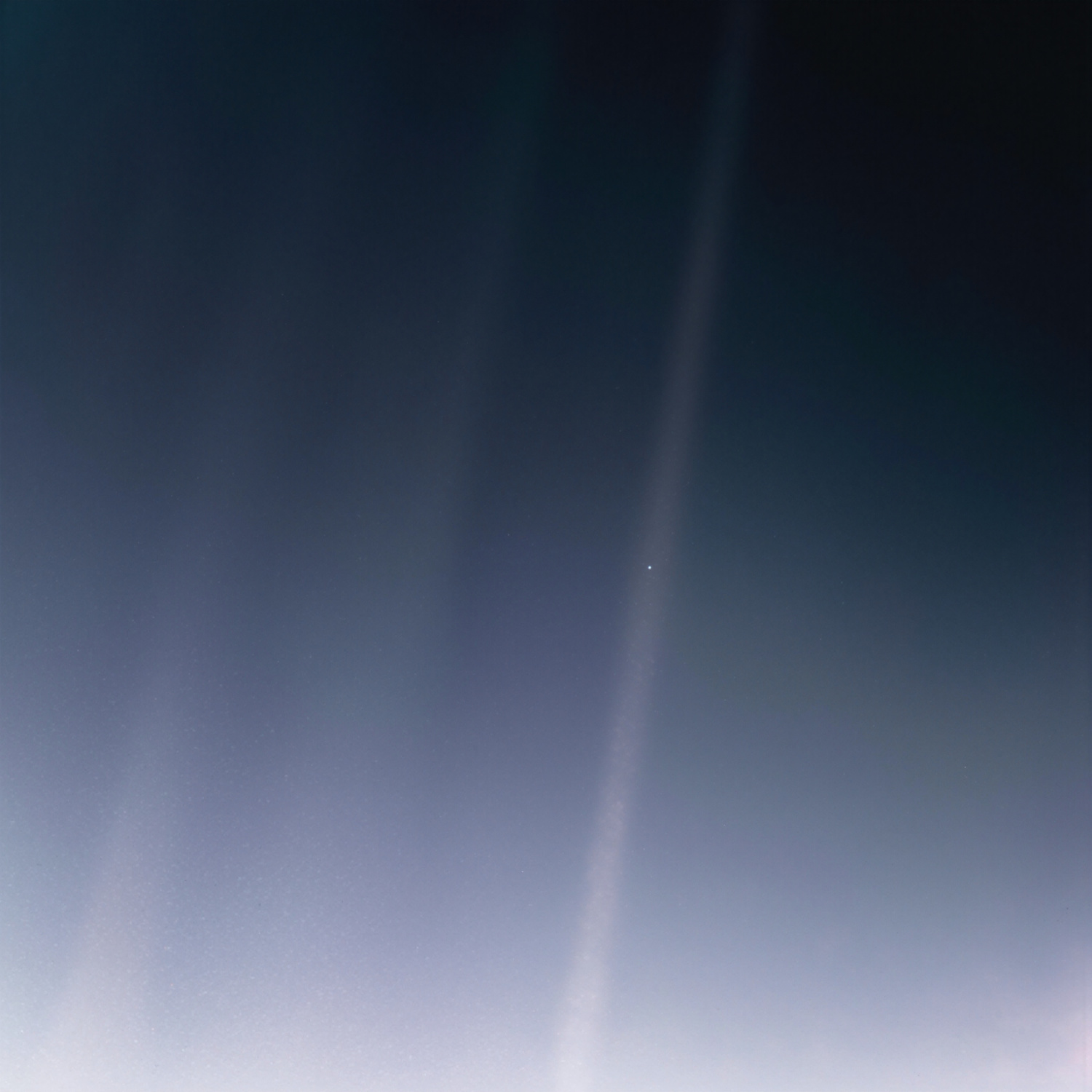Where Art Becomes
As I look at the following image, I ask three questions:
How does this make me feel?
What thoughts come to mind?
Can art be this simple?
I look for thirty seconds as I consider these questions.
A Pale Blue Dot
Thirty seconds can seem like a long time when there are only a few elements to consider. I find the act of looking at a still image this long is valuable.
Blue is my favourite colour.
For me, the pale blue dot and square boundary, the white background and where they are placed work well together. I feel calm.
I enjoy simplicity and I experience something expressed elegantly with only a few elements as poetic. I feel pleasure.
I associate the blue dot with the earth, although in this work the darkness of space is replaced with its opposite: light. I feel curiosity.
Although the image is sparse, the more time I spend looking, the more meaningful this work becomes to me.
I think of the natural world and consider how it is confined by the blue boundary of the atmosphere. Perhaps the square boundary of the image is a metaphor for how the earth is shaped and confined by human influence.
There is a fourth element that is situated immediately below the work: the title 'A Pale Blue Dot'. This mirrors a phrase I first heard Carl Sagan say many years ago. He reflected on the earth as it was captured in an image far out into space.
The placement of the dot in the centre of the square encourages me to think about how human's so often place their own interests at the centre of how they operate in the world.
My thoughts about viewing the earth from this broader perspective, lead me to the ideas of Galileo di Vincenzo Bonaiuti de' Galilei, the Italian astronomer, physicist and engineer who argued that the earth was not the centre of the universe.
Despite its simple form, the more I think and feel, the more I experience this work as art.
When I first began creating 'A Pale Blue Dot', I chose 'A Single Dot' as its name. I intended to express the very smallest of artistic gestures, and to interrogate whether this could amount to a work of art. At this draft stage there was no square boundary. The dot was however blue, and this together with its placement indicated purpose and care.
I increased the size of the blue dot so that it offers a more intense, closer view.
Although I did not initially think of Carl Sagan's passage about the earth when creating A Pale Blue Dot, I became mindful of this as I began to work and ponder more.

The photograph of Earth that was taken on February 14, 1990, by NASA’s Voyager 1, 3.7 billion miles (6 billion kilometres) from the Sun inspired Carl Sagan's beautiful passage below about our world.
Earth is visible as a tiny bright speck around half way down within a thin sunbeam just right of centre.
The original photograph 'Pale Blue Dot' was updated by NASA in 2020 (above) to show how it would have appeared to human eyes.
"...From this distant vantage point, the Earth might not seem of any particular interest. But for us, it's different. Consider again that dot. That's here. That's home. That's us. On it everyone you love, everyone you know, everyone you ever heard of, every human being who ever was, lived out their lives. The aggregate of our joy and suffering, thousands of confident religions, ideologies, and economic doctrines, every hunter and forager, every hero and coward, every creator and destroyer of civilization, every king and peasant, every young couple in love, every mother and father, hopeful child, inventor and explorer, every teacher of morals, every corrupt politician, every "superstar", every "supreme leader", every saint and sinner in the history of our species lived there – on a mote of dust suspended in a sunbeam..."
"Pale Blue Dot: A Vision of the Human Future in Space" 1994, Carl Sagan.
One of many valuable qualities about art is its ability to offer new perspectives. My effort with 'A Pale Blue Dot' is to provide another way to ponder on the beauty and wonder of the earth, and to consider how such a simple gesture as placing a small blue dot on a white background, bordered by a pale blue square can be experienced as art.
Although A Pale Blue Dot was relatively easy to make, this does not reduce its value as art. The value of something is not undermined by its ease of creation or prevalence. Consider the qualities of kindness and love. These are easily expressed, and when plentiful, we do not value them any less.
When things are commonplace, it is however more difficult to assert ownership, although some will control even these things. Take food as an example. Humans produce enough food so that no one in the world need go without, and yet because of conflict, poverty, distribution, climate change, politics and power, but above all the concept of ownership, millions starve.
Ownership is an idea born of the insecurity that something I have might be taken away. Ownership is also a vehicle that is used to profit and control. Like its sibling, money, it has no intrinsic value, and without social agreement or political compulsion, it has no meaning.
A Pale Blue Dot is not for sale. The artwork can be enjoyed by anyone with an Internet connection. Open A Pale Blue Dot in a new tab to view and/or save the full size work.
By removing the transactional process that masks the true value of art, it is possible to focus wholly on its beauty and significance. To be art, it must reveal. My message with a simple gesture of offering this art freely is that the earth is not owned, but a place of belonging.
. . .